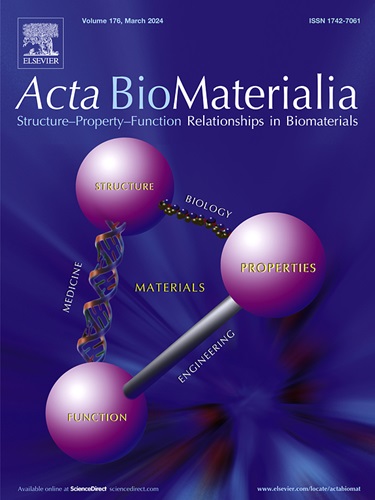Enhancing titanium dioxide nanotube array stability on dental implants through laser lithography–assisted microline patterning
IF 9.4
1区 医学
Q1 ENGINEERING, BIOMEDICAL
引用次数: 0
Abstract
Titanium dioxide nanotube arrays (TNTs) generated in situ on the surface of dental implants have been shown to enhance bone integration for load-bearing support while managing load distribution and energy dissipation to prevent bone resorption from overload. However, their inadequate stability limits the clinical use of conventional TNTs. This study introduces an innovative approach to improve the mechanical stability of TNTs while maintaining their bone-integration efficiency. The method involved creating microline patterns on TNTs (L-TNTs), where the TNTs were embedded within grooves for enhanced protection. This was achieved through a combination of laser lithography–assisted microline patterning and anodization. Incorporation of microline patterns significantly increased the mechanical stability of the TNTs. This improvement was evidenced by multiple tests: peeling tests demonstrated the maximum adhesive strength of the L-TNTs increased by at least 50 %; friction-wear tests revealed narrower, shallower abrasion patterns and lower average friction coefficients; and ex vivo screw implant insertion and removal tests showed post-insertion, the nanotube structures in the TNTs peeled, whereas those in the L-TNTs remained intact. The L-TNTs also maintained their efficacy in promoting bone integration both in vitro and in vivo, establishing a robust platform for multifunctional implant investigation and advancing the practical application of TNTs.
Statement of significance
This study presents a novel laser lithography–assisted micropatterning and anodization method for creating micro-lined titanium dioxide nanotube arrays (L-TNTs) on dental implants. Compared to conventional TNTs, L-TNTs enhanced adhesive strength and wear resistance while maintaining efficacy in promoting bone integration. This method enhances the mechanical stability of TNTs, facilitating its practical application in multifunctional dental implants.

在牙科植入物表面原位生成的二氧化钛纳米管阵列(TNTs)已被证明可以增强骨整合以获得承重支持,同时管理负载分布和能量消耗,防止超载引起的骨吸收。然而,传统 TNTs 的稳定性不足,限制了其临床应用。本研究介绍了一种创新方法,在保持骨整合效率的同时提高 TNT 的机械稳定性。该方法包括在 TNTs 上创建微线图案(L-TNTs),将 TNTs 嵌入凹槽中以加强保护。这是通过激光光刻辅助微线图案化和阳极氧化相结合的方法实现的。微线图案的加入大大提高了 TNT 的机械稳定性。多项测试证明了这种改进:剥离测试表明,L-TNTs 的最大粘合强度至少提高了 50%;摩擦磨损测试表明,磨损图案更窄、更浅,平均摩擦系数更低;体内螺钉植入和移除测试表明,TNTs 中的纳米管结构在植入后会剥离,而 L-TNTs 中的纳米管结构则保持完好。L-TNTs 在体外和体内也保持了促进骨整合的功效,为多功能植入物研究建立了一个强大的平台,推动了 TNTs 的实际应用。意义说明:本研究提出了一种新颖的激光光刻辅助微图案化和阳极氧化方法,用于在牙科植入物上创建微衬里二氧化钛纳米管阵列(L-TNTs)。与传统的 TNT 相比,L-TNT 增强了粘接强度和耐磨性,同时保持了促进骨整合的功效。该方法增强了 TNTs 的机械稳定性,有助于其在多功能牙科植入物中的实际应用。
本文章由计算机程序翻译,如有差异,请以英文原文为准。
求助全文
约1分钟内获得全文
求助全文
来源期刊

Acta Biomaterialia
工程技术-材料科学:生物材料
CiteScore
16.80
自引率
3.10%
发文量
776
审稿时长
30 days
期刊介绍:
Acta Biomaterialia is a monthly peer-reviewed scientific journal published by Elsevier. The journal was established in January 2005. The editor-in-chief is W.R. Wagner (University of Pittsburgh). The journal covers research in biomaterials science, including the interrelationship of biomaterial structure and function from macroscale to nanoscale. Topical coverage includes biomedical and biocompatible materials.
 求助内容:
求助内容: 应助结果提醒方式:
应助结果提醒方式:


